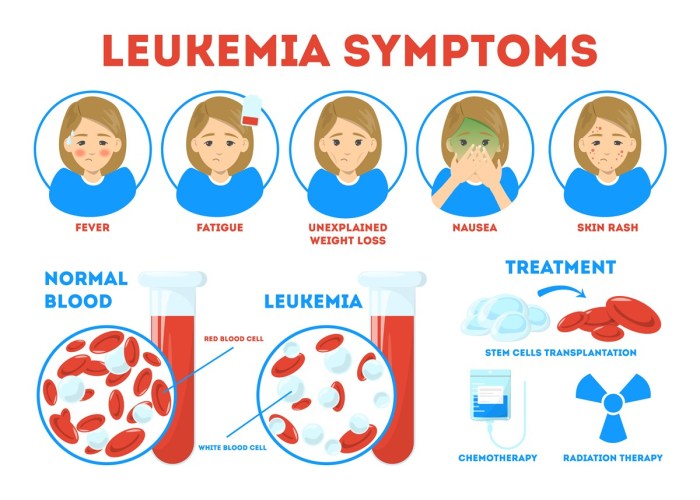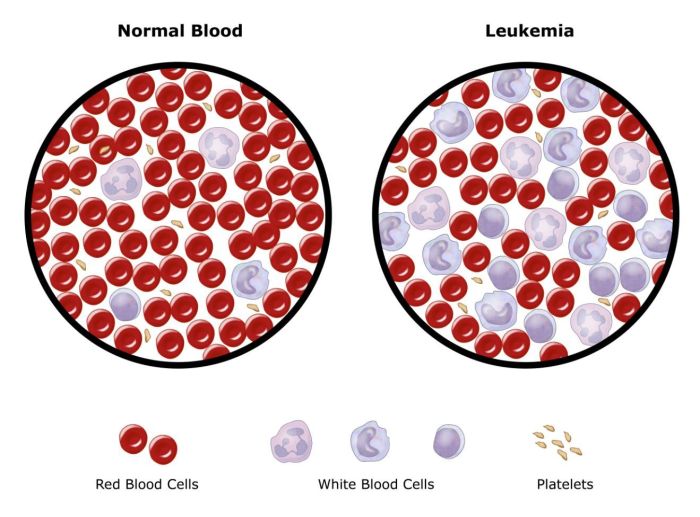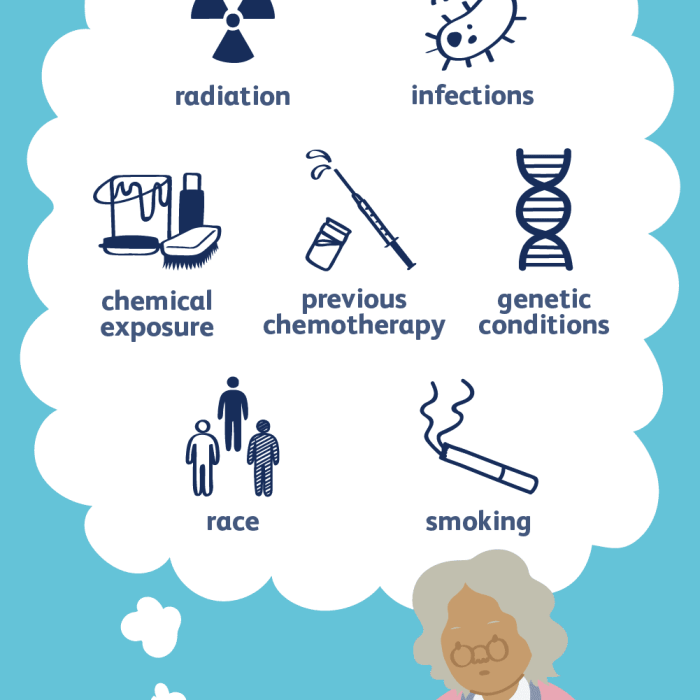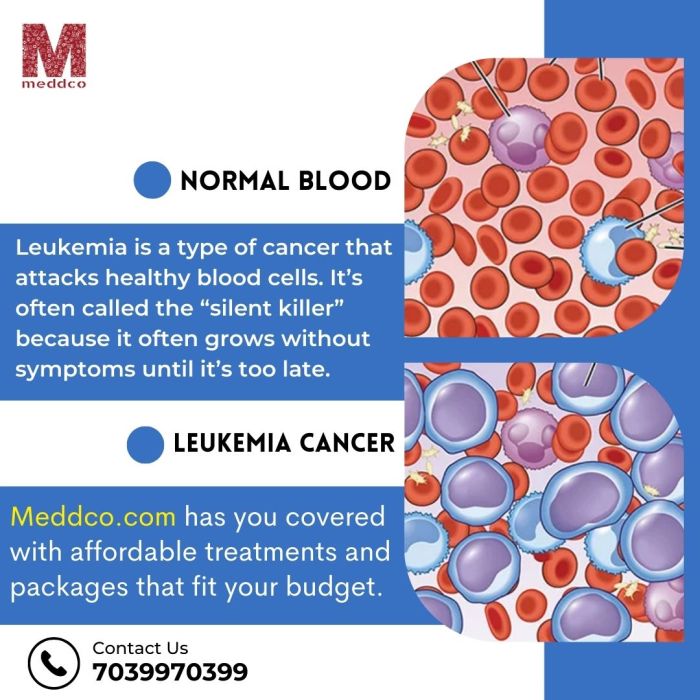Embark on a self-assessment journey with our Do I Have Leukemia Quiz. Explore common symptoms, risk factors, and diagnostic procedures to gain a deeper understanding of this condition.
Leukemia, a type of cancer affecting blood-forming tissues, manifests in various forms. Understand the differences between acute and chronic, myeloid and lymphoid leukemia to identify potential signs and symptoms.
Leukemia Overview

Leukemia is a type of cancer that affects the blood-forming tissues of the body, including the bone marrow and the lymphatic system. Leukemia is characterized by the rapid production of abnormal white blood cells, which can interfere with the normal function of the blood and bone marrow.
Types of Leukemia
There are many different types of leukemia, classified based on the type of blood cell affected and the rate of progression. Some common types of leukemia include:
- Acute leukemia:This type of leukemia is characterized by the rapid growth and spread of abnormal white blood cells. Acute leukemia can be either myeloid or lymphoid, depending on the type of blood cell affected.
- Chronic leukemia:This type of leukemia is characterized by the slow growth and spread of abnormal white blood cells. Chronic leukemia can also be either myeloid or lymphoid, depending on the type of blood cell affected.
- Myeloid leukemia:This type of leukemia affects the myeloid cells, which are a type of white blood cell that includes neutrophils, monocytes, and eosinophils.
- Lymphoid leukemia:This type of leukemia affects the lymphoid cells, which are a type of white blood cell that includes lymphocytes.
Symptoms of Leukemia

Leukemia is a type of cancer that starts in the blood-forming tissue of the bone marrow. It can affect the production of red blood cells, white blood cells, and platelets, leading to a range of symptoms.
The symptoms of leukemia can vary depending on the type of leukemia, but some common symptoms include:
- Fatigue
- Fever
- Bruising or bleeding easily
- Weight loss
- Swollen lymph nodes
- Bone or joint pain
- Shortness of breath
- Night sweats
- Frequent infections
These symptoms can also be caused by other conditions, so it’s important to see a doctor if you’re experiencing any of them.
Fatigue
Fatigue is one of the most common symptoms of leukemia. It can be caused by the leukemia cells themselves, or by the body’s response to the leukemia.
Fever
Fever is another common symptom of leukemia. It can be caused by the leukemia cells themselves, or by the body’s response to the leukemia.
Bruising or Bleeding Easily
Bruising or bleeding easily is a common symptom of leukemia. It can be caused by the leukemia cells damaging the blood vessels.
Weight Loss
Weight loss is a common symptom of leukemia. It can be caused by the leukemia cells using up the body’s energy stores.
Diagnosis of Leukemia

Diagnosing leukemia involves a comprehensive process that combines various tests and examinations to accurately identify the type and extent of the disease.
The diagnostic journey typically begins with a thorough medical history and physical examination, where your doctor will inquire about your symptoms, lifestyle, and family history. This initial assessment helps narrow down the potential causes of your symptoms and guide further testing.
Blood Tests, Do i have leukemia quiz
Complete Blood Count (CBC): A CBC is a routine blood test that measures the levels of various blood cells, including white blood cells (WBCs), red blood cells (RBCs), and platelets. In leukemia, abnormal levels or appearances of these cells can indicate the presence of the disease.
Peripheral Blood Smear: A peripheral blood smear involves examining a sample of blood under a microscope to assess the size, shape, and maturity of blood cells. This test can help identify abnormal cells, such as immature or blast cells, which are characteristic of leukemia.
Flow Cytometry: Flow cytometry is a specialized blood test that uses fluorescent markers to identify and count different types of white blood cells. This test can help determine the specific type of leukemia and its stage.
Bone Marrow Biopsy and Aspiration
Bone marrow biopsy and aspiration are essential procedures for diagnosing leukemia. These tests involve removing a small sample of bone marrow from the hip bone using a needle. The bone marrow sample is then examined under a microscope to assess the presence and characteristics of leukemia cells.
If you’re concerned about leukemia, taking the “Do I Have Leukemia Quiz” can be a helpful first step. While the quiz can provide some guidance, it’s important to consult with a medical professional for an accurate diagnosis. One fascinating study that sheds light on the genetic factors associated with leukemia is the Battle of the Beaks Lab . This research explores how beak shape in birds can influence their susceptibility to leukemia, providing valuable insights into the complexities of the disease.
By combining the information from the quiz with further research, you can gain a better understanding of your potential risk and seek appropriate medical advice if necessary.
Bone marrow biopsy provides a more comprehensive view of the bone marrow compared to aspiration, allowing for a more accurate diagnosis and evaluation of the extent of leukemia.
Imaging Tests
Imaging tests, such as X-rays, CT scans, and MRIs, may be used to assess the extent of leukemia and its impact on various organs. These tests can detect enlarged lymph nodes, organ involvement, or other abnormalities associated with leukemia.
Treatment Options for Leukemia
Treatment options for leukemia vary depending on the type of leukemia, the patient’s age and overall health, and the stage of the disease. The goal of treatment is to eliminate leukemia cells from the body and restore normal blood cell production.
The main treatment options for leukemia include:
Chemotherapy
Chemotherapy uses powerful drugs to kill leukemia cells. It can be given intravenously, orally, or both. Chemotherapy is often used in combination with other treatments, such as radiation therapy or targeted therapy.
Radiation Therapy
Radiation therapy uses high-energy radiation to kill leukemia cells. It can be given externally, using a machine that directs radiation to the affected area, or internally, using radioactive implants placed directly into the body.
Targeted Therapy
Targeted therapy uses drugs that specifically target leukemia cells. These drugs are designed to interfere with the growth and spread of leukemia cells while leaving healthy cells unharmed.
Stem Cell Transplant
A stem cell transplant involves replacing the patient’s diseased bone marrow with healthy stem cells. The stem cells can come from the patient’s own body (autologous transplant) or from a donor (allogeneic transplant).
Prognosis and Survival Rates

The prognosis and survival rates for leukemia patients vary depending on several factors, including the type of leukemia, the stage of diagnosis, and the response to treatment.
In general, the five-year survival rate for all types of leukemia is around 60%. However, the survival rate for some types of leukemia, such as acute lymphoblastic leukemia (ALL), is much higher (around 90%), while the survival rate for other types of leukemia, such as acute myeloid leukemia (AML), is lower (around 25%).
Factors Affecting Prognosis
- Type of leukemia:The type of leukemia is one of the most important factors that affect prognosis. Some types of leukemia, such as ALL, are more curable than others, such as AML.
- Stage of diagnosis:The stage of leukemia at diagnosis also affects prognosis. Leukemia that is diagnosed at an early stage is more likely to be curable than leukemia that is diagnosed at a later stage.
- Treatment response:The response to treatment is another important factor that affects prognosis. Patients who respond well to treatment are more likely to have a good prognosis than patients who do not respond well to treatment.
Risk Factors for Leukemia

While the exact cause of leukemia is often unknown, certain factors can increase the risk of developing the disease. Understanding these risk factors can help individuals take proactive steps to reduce their chances of developing leukemia.
Exposure to certain chemicals, such as benzene and formaldehyde, has been linked to an increased risk of leukemia. These chemicals are commonly found in industrial settings, and individuals working in these environments should take appropriate precautions to minimize exposure.
Radiation Exposure
Radiation exposure, both ionizing and non-ionizing, can damage DNA and increase the risk of leukemia. Ionizing radiation, such as X-rays and gamma rays, is particularly harmful and has been associated with an increased risk of leukemia in individuals exposed to it for medical or occupational reasons.
Genetic Predispositions
Certain genetic conditions can increase the risk of developing leukemia. For example, individuals with Down syndrome have a higher risk of developing acute myeloid leukemia (AML). Additionally, individuals with a family history of leukemia may have an increased risk of developing the disease themselves.
Lifestyle Factors
Certain lifestyle factors, such as smoking and excessive alcohol consumption, have been associated with an increased risk of leukemia. Smoking damages DNA and can lead to the development of leukemia, particularly AML. Excessive alcohol consumption can suppress the immune system, making individuals more susceptible to infections and potentially increasing the risk of leukemia.
Prevention and Screening

While specific preventive measures for leukemia are limited, early detection and regular check-ups play a crucial role in managing the risk of developing the disease. Screening tests can help identify early signs of leukemia, allowing for prompt diagnosis and treatment.
Early Detection and Regular Check-Ups
Regular blood tests and physical examinations can detect abnormalities in blood cell counts or other indicators that may suggest leukemia. Early detection is essential for successful treatment, as it increases the chances of achieving remission and improving survival rates.
Individuals with a family history of leukemia or those who have been exposed to certain risk factors, such as radiation or certain chemicals, should consider more frequent check-ups to monitor their blood health.
FAQ Resource: Do I Have Leukemia Quiz
What are the most common symptoms of leukemia?
Fatigue, fever, bruising, weight loss, and frequent infections are common symptoms.
Can leukemia be cured?
Treatment options vary depending on the type and stage of leukemia. While some types are curable, others require ongoing management.
What are the risk factors for leukemia?
Exposure to radiation, certain chemicals, and genetic predispositions can increase the risk of developing leukemia.